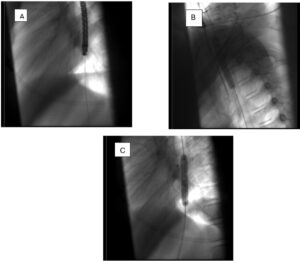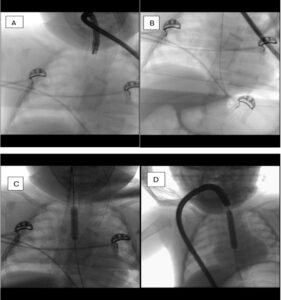Rabia Shah¹*, Rawan Alhalabi2, Aws Alfahad3, Dalia Belsha4
¹Pediatrician, American Hospital Dubai, Dubai
²Resident Pediatrician, American Hospital Dubai, Dubai
³Consultant Interventional Radiology, American Hospital Dubai, Dubai
⁴Consultant Pediatric Gasteroenetrology, American Hospital Dubai, Dubai
*Corresponding author: Rabia Shah, Pediatrician, American Hospital Dubai, Dubai; Email: [email protected]
Published Date: 21-10-2024
Copyright© 2024 by Shah R, et al. All rights reserved. This is an open access article distributed under the terms of the Creative Commons Attribution License, which permits unrestricted use, distribution, and reproduction in any medium, provided the original author and source are credited.
Abstract
This report highlights the management of two complex oesophageal strictures using an innovative combined endoscopic and fluoroscopic technique. The first case involves a 12-year-old boy with epidermolysis bullosa, where conventional endoscopic methods were inadequate. The second case details a premature infant with an anastomotic stricture post-oesophageal atresia repair. Both patients underwent successful dilation with a neonatal endoscope and fluoroscopic guidance, overcoming significant technical challenges. This approach demonstrates a promising alternative for handling severe and refractory oesophageal strictures.
Keywords: Oesophageal Strictures; Fluoroscopy; Neonatal
Introduction
Oesophageal stricture, a narrowing of the oesophageal lumen, typically presents with dysphagia (difficulty swallowing) and is caused by conditions such as inflammation, fibrosis or neoplasm [1]. These strictures are commonly managed using a combination of dietary modifications, medical therapy, endoscopic balloon dilation, stent placement or surgical intervention [2]. The most frequently utilized technique is endoscopic dilation with a balloon dilator [1]. Barium studies assist in visualizing key features of the stricture, such as its level, length and severity, particularly when conventional endoscopes cannot traverse the narrow lumen.
In this paper, we present two cases where standard endoscopic size failed to pass due to severely contracted oesophageal lumens. In both cases, a combination of endoscopic and fluoroscopic techniques was successfully employed to manage the challenging anatomical features.
Case Report
Case 1
A 12-year-old boy presented with dysphagia and retrosternal burning, persisting for several weeks. Four years earlier, he had undergone balloon dilation for an oesophageal stricture. The patient had noticeable skin scarring on his lower limbs. His BMI was 16 and he appeared pale with signs of malnutrition. Physical examination revealed epigastric tenderness and skin lesions with scarring on the lower limbs. Laboratory results showed a low ferritin level of 9.2 µg/L, alkaline phosphatase of 154 U/L and a normal 25-hydroxyvitamin D level of 59.8 nmol/L.
A barium swallow study demonstrated a distal oesophageal stricture measuring 25-30 mm in length. Given the suspicion of a genetic condition involving both skin and oesophageal manifestations, whole genome sequencing was performed, confirming a diagnosis of autosomal recessive Dystrophic Epidermolysis Bullosa (DEB).
The patient was initiated on oral esomeprazole and a liquid diet, with intravenous iron infusion to address the iron deficiency. Endoscopic balloon dilation was planned. Due to the friable nature of the oesophageal mucosa, a neonatal endoscope was chosen to minimize trauma. During the procedure, a severe proximal oesophageal stricture was noted. Since the balloon catheter could not pass through the neonatal standard endoscopic guided balloon dilatation technique was not possible. Combined endoscopy and fluoroscopic guided balloon dilatation technique was implemented with first step involves advancing an 0.35 mm straight tip guidewire via the scope channel under direct visualisation. The endoscopy allowed localisation of the oesophageal stricture which was marked on the fluoroscopy screen. The endoscope was removed while keeping the guide wire in place. The next step involved advancing the balloon catheter over the wire under fluoroscopic guidance. This was followed by sequential dilations of 6 mm, 7 mm and 8 mm as previously agreed based on patient weight and size of stricture. This allowed for the neonatal endoscope to pass through the proximal oesophageal stricture and a second stricture was identified at 30 cm. Fluoroscopic guided balloon dilatation technique was repeated successfully as in the previous steps (Fig. 1).

Figure 1: Neonatal endoscope passed, identifying the stricture and guiding the wire (A), Balloon catheter dilatation of proximal oesophagus under fluoroscopic guidance (B), Balloon catheter dilatation of distal oesophagus under fluoroscopic guidance (C).
Case 2
A newborn girl was delivered at 36 weeks of gestation had post-natal diagnosis of oesophageal atresia. On the second day of life, the neonate underwent surgery for Type C tracheoesophageal fistula, involving ligation of the fistula and reconstruction of the proximal oesophagus via a right posterolateral thoracotomy. The postoperative NICU stay lasted 14 days and was uncomplicated.
At six weeks of age, she presented with cyanotic episodes post-feeding. A barium swallow revealed a proximal oesophageal stricture less than 1 cm in length at the T2-T3 vertebral level, at the site of previous reconstruction. Given the difficulty passing a balloon catheter through the neonatal scope, she was commenced on NG feeding with amino acid formula aiming for adequate weight gain before considering the dilation. Bronchoscopy revealed severe tracheomalacia involving almost the entire trachea, which improved with nighttime CPAP therapy. At seven months of age with weight of five Kg, we elected to proceed with the same combined endoscopy fluoroscopy technique. After passing the guidewire into the neonatal scope, then removing the scope and sliding the balloon catheter into the guidewire, a hydrostatic balloon dilation to 7 mm and 8 mm, each lasting one minute was successfully performed under direct fluoroscopic guidance. The procedure was well tolerated and subsequent endoscopy confirmed successful passage to the stomach without further complications (Fig. 2).

Figure 2: Neonatal scope into the oesophagus (A), Neonatal endoscope passed, guidewire in the oesophagus and tip of wire at gastroesophageal junction (B), Neonatal endoscope removed and balloon catheter introduced over the wire using flouroscopic guidance for serial dilation at 7 and 8 mm (C), Paediatric endoscope used the second time to pass guidewire and balloon catheter (D).
Discussion
Oesophageal strictures can significantly impact symptomatology, quality of life and nutritional status. Various treatment approaches have been advocated to manage these strictures effectively. Dietary modifications are beneficial in cases with minimal symptoms [3]. Nevertheless, in our patients, conservative treatments were initially employed until they were deemed suitable for more invasive interventions.
Endoscopic balloon dilation remains the treatment of choice for oesophageal strictures with success rates exceeding 80% [4,5]. Despite its efficacy, endoscopic treatment of refractory, complex and challenging oesophageal strictures presents ongoing obstacles for many endoscopists [6]. As a result, alternative techniques such as temporary stent placement and incisional therapy have been explored as adjuncts to traditional endoscopic dilation [7].
Managing oesophageal stricture as a complication of Epidermolysis Bullosa (EB) presents noteworthy challenges due to the increased risk of mucosal injury. Balloon dilation is the standard care for EB-related strictures; however, it may lead to stricture recurrence and mucosal damage. Numerous techniques have been developed to alleviate these risks. For instance, in cases of microstomia, which obscures the passage of endoscopes, a retrograde approach to dilation has been used. Furthermore, a study involving 34 EB patients demonstrated the use of balloon dilation under fluoroscopy alone, with guidewire passage through the nostril to avoid endoscopic insertion [8].
In the paediatric population, particularly in infants, anastomotic stricture can occur as a sequelae of oesophageal atresia repair. Standard approaches include oesophageal dilation, with adjunctive therapies such as steroid injections, mitomycin C application, oesophageal stents and in rare cases, stricture resection or oesophageal replacement. Our cases illustrate that complex strictures may not respond well to through-the-scope dilators, necessitating alternative approaches [9].
In both cases presented, the major challenge was the risk of mucosal injury and age/weight constraints. The use of a neonatal endoscope was valuable in minimizing mucosal trauma in the patient with EB and accommodating the narrow oesophageal lumen in the infant. Although the dilation catheter could not pass through the endoscope, the guidewire was successfully advanced to the gastroesophageal junction. Dilation was then performed under fluoroscopic guidance after eliminating the endoscope and demonstrating the stricture site.
Some endoscopist advocate passing the catheter blindly next to the scope, this can be difficult as diameter of the oesophagus is small as well it can risk blind injury to the oesophageal lining from the catheter. Using our technique is proven to be safe and minimise risk of complication and at the same time allow dilating strictures at smaller sizes.
Despite the promising outcomes, there might be limitations to this approach. The reliance on advanced imaging and specialized, well-skilled, physicians may not be available in all clinical settings, which could restrict the generalizability of this technique. Moreover, the cases presented are relatively small and further studies are needed to validate these findings in a larger cohort. The potential risks associated with fluoroscopic exposure and the technical complexity of combining these techniques should also be contemplated.
To our knowledge, the specific technique employed in our setup utilizing a neonatal endoscope in conjunction with fluoroscopic guidance for dilation has not been previously reported. This innovative approach enabled precise identification and management of strictures, demonstrating its potential as a valuable tool in the treatment of complex oesophageal strictures.
Conclusion
In conclusion, the novel approach using a neonatal endoscope represents a significant advancement in the management of oesophageal strictures. This technique enhances patient safety by minimizing the risk of mucosal injury and addresses the challenge of passing a dilator through the neonatal endoscope by employing fluoroscopic guidance after the endoscope is removed. We emphasize that having a skilled team of endoscopists and interventional radiologists is essential for optimal performance. By combining fluoroscopy with endoscopy, more precise and effective dilation can be achieved, ultimately improving outcomes for patients with challenging oesophageal strictures.
Conflict of Interests
The authors have no conflict of interest to declare.
References
- Desai JP, Moustarah F. Esophageal stricture. StatPearls Publishing. 2024.
- De Angelis P, Caldaro T, Torroni F, Romeo E, Foschia F, di Abriola GF, et al. Esophageal stenosis in epidermolysis bullosum: a challenge for the endoscopist. J Pediatric Surg. 2011;46(5):842-7.
- Anderson BT, Feinstein JA, Kramer RE, Narkewicz MR, Bruckner AL, Brumbaugh DE. Approach and safety of esophageal dilation for treatment of strictures in children with epidermolysis bullosa. J Pediatric Gastroenterol Nutr. 2018;67(6):701-5.
- Siersema PD. Treatment options for esophageal strictures. Nature Clinical Practice Gastroenterol Hepatol. 2008;5(3):142-52.
- Olson CG, Vora H, Kröner PT, Pang M. Esophageal stricture recalcitrant to repeated dilation in complex rheumatological disease. ACG Case Reports J. 2022;9(12):e00940.
- Abad MRA., Fujiyoshi Y, Inoue H. Flexible endoscopic strategies for the difficult esophageal stricture. Current Opinion in Gastroenterol. 2020.
- Siersema PD. Treatment options for esophageal strictures. Nature Clinical Practice Gastroenterol Hepatol. 2008;5(3):142-52.
- De Angelis P, Caldaro T, Torroni F, Romeo E, Foschia F, di Abriola GF, et al. Esophageal stenosis in epidermolysis bullosum: a challenge for the endoscopist. J Pediatric Surg. 2011;46(5):842-7.
- Baird R, Laberge JM, Lévesque D. Anastomotic stricture after esophageal atresia repair: a critical review of recent literature. Euro J Pediatric Surg. 2013;23(03):204-13.
Article Type
Case Report
Publication History
Received Date: 27-09-2024
Accepted Date: 14-09-2024
Published Date: 21-10-2024
Copyright© 2024 by Shah R, et al. All rights reserved. This is an open access article distributed under the terms of the Creative Commons Attribution License, which permits unrestricted use, distribution, and reproduction in any medium, provided the original author and source are credited.
Citation: Shah R, et al. Oesophageal Dilation Using Combined Fluoroscopy Guidance and Neonatal Scope: Overcoming Narrow Lumen Challenges in Paediatric Cases- Two Case Reports. J Pediatric Adv Res. 2024;3(3):1-5.

Figure 1: Neonatal endoscope passed, identifying the stricture and guiding the wire (A), Balloon catheter dilatation of proximal oesophagus under fluoroscopic guidance (B), Balloon catheter dilatation of distal oesophagus under fluoroscopic guidance (C).

Figure 2: Neonatal scope into the oesophagus (A), Neonatal endoscope passed, guidewire in the oesophagus and tip of wire at gastroesophageal junction (B), Neonatal endoscope removed and balloon catheter introduced over the wire using flouroscopic guidance for serial dilation at 7 and 8 mm (C), Paediatric endoscope used the second time to pass guidewire and balloon catheter (D).


